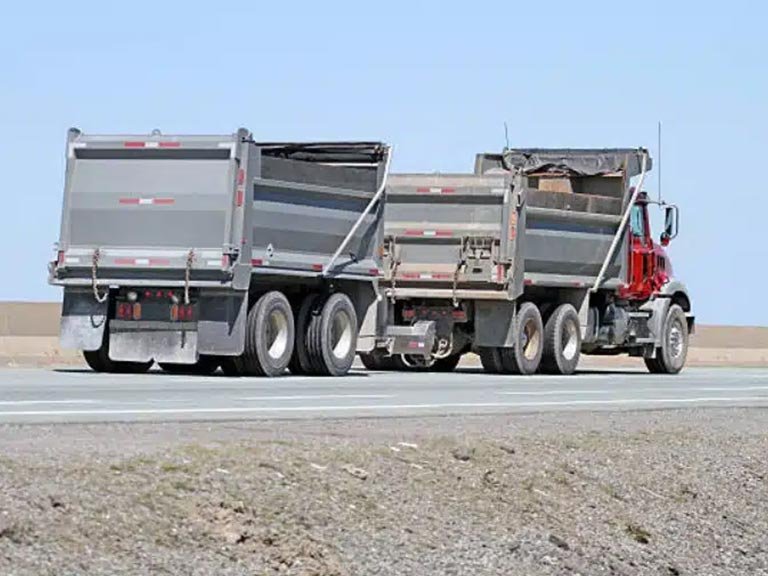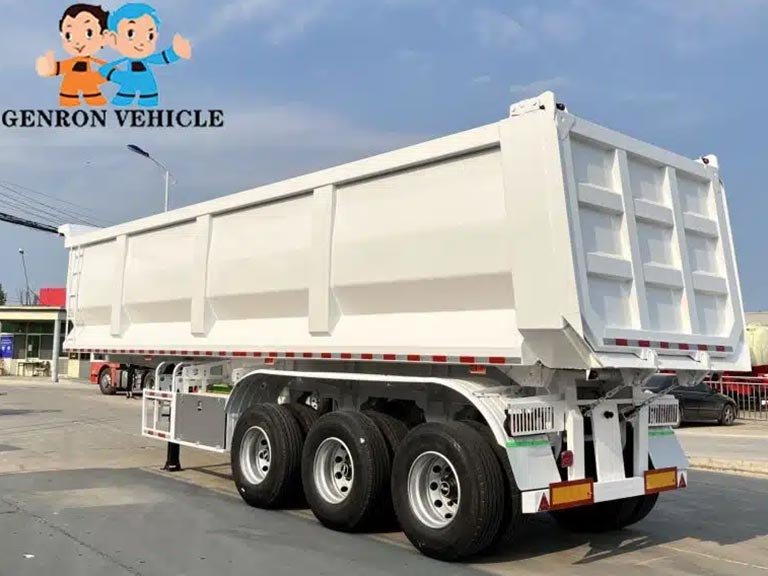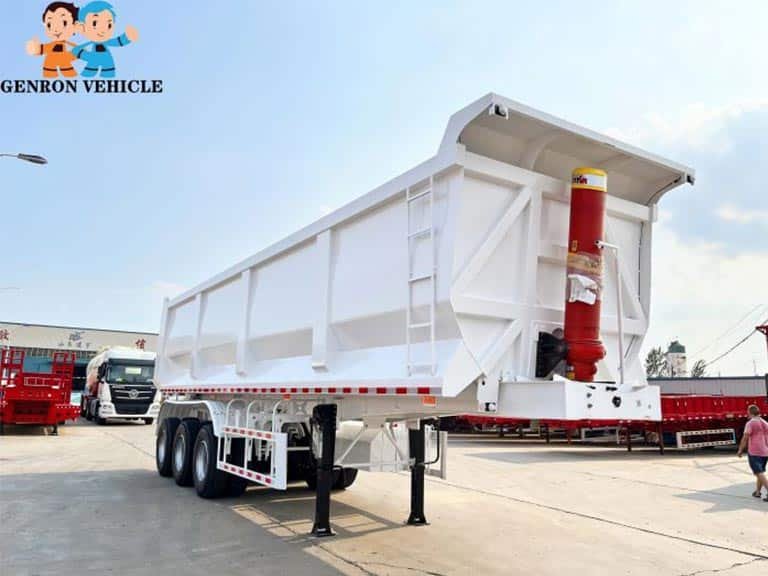Looking for the right equipment to haul heavy loads efficiently? The dimensions of an end dump trailer are key to its hauling capacity and job suitability. Understanding the dimensions of an end dump trailer is crucial for ensuring it meets specific transportation needs and regulatory standards. This article details the dimensions of end dump trailers, highlighting their versatility, typical sizes, and how these dimensions impact functionality.
Table of Contents
Standard Dimensions Of An End Dump Trailer
Understanding the standard dimensions of an end dump trailer is crucial. These dimensions affect the trailer’s capacity, efficiency, and safety.
- Length Specifications: End dump trailers vary in length, impacting their capacity. Standard lengths include 40-foot trailers. The length significantly influences the trailer’s cubic capacity.
- Width and Height Measurements: The width and height of an end dump trailer are vital. A typical configuration is 102 inches wide and 76 inches high. This provides substantial capacity. Variations in height, like 100-inch sides, can increase capacity.
Capacity and Weight Ratings
Capacities range from 20 Cu Yd to 95 Cu Yd, depending on dimensions. For example, a 40′ Length x 102″ Width x 76″ Side Height trailer offers 65 Cubic Yards of capacity. Weight ratings are determined by axle configuration. Tandem axles support 50,000 pounds through a single-point suspension system, ensuring stability.
- End dump trailer capacities range from 20 to 95 cubic yards, influenced by their dimensions.
- A standard 40-foot trailer with 76-inch sides typically offers 64-65 cubic yards of capacity.
- Weight distribution across the suspension system is critical for maintaining stability.
Begin with a bespoke semi-trailer designed for your exact needs. Whether it’s heavy-duty hauling or specialized cargo, we’ve got the perfect solution to keep you moving forward.
Key Design Features Affecting Trailer Dimensions
End dump trailer dimensions are influenced by several key design features. These features affect the trailer’s overall size, operational efficiency, and capacity.
- Body Design and Construction: The design and materials of an end dump trailer greatly influence its size. For example, certain types of end dump trailers feature a sturdy and durable design with vertical rear panels and support beams. This design boosts the trailer’s cubic capacity. The choice of materials also impacts the trailer’s weight and durability.
- Suspension Systems: The suspension system is key in determining the trailer’s dimensions and performance. A well-designed system offers a smoother ride and better stability. This can affect the trailer’s height and operational clearance.
- Tailgate Options and Configurations: Tailgate configurations are vital in determining the trailer’s effective length and operational clearance. High-lift tailgates, for instance, provide 76 inches of clearance. This prevents damage from large materials during discharge. Common options include high-lift, top-hinged gravity, and barn door configurations.
Size Variations Based on Capacity and Use
End dump trailers are designed with different capacities based on their intended use. Capacity typically ranges from 40 to 150 tons. Trailers used for heavy-duty applications, such as construction or mining, usually have larger dimensions and higher weight capacities to accommodate bulk materials like gravel, sand, or demolition debris.
The type of material being transported also affects trailer design. Trailers for lighter but bulkier materials might have higher sides to increase volume without exceeding weight limits. Conversely, trailers for denser materials, like ore or stone, might be shorter but more robust to handle the weight.

Impact of Dimensions on Performance
The size of an end dump trailer directly affects its performance and efficiency. Larger trailers can transport more material per trip, increasing productivity and reducing operational costs. However, it’s crucial to ensure the trailer size is compatible with the towing vehicle and can navigate planned routes, including bridges and tunnels.
Proper size and weight distribution are vital for maintaining stability during transport and unloading. A well-balanced trailer reduces the risk of tipping on uneven terrain. This balance is achieved through careful design and the strategic placement of axles, suspension systems, and hydraulic components.
Materials and Construction
End dump trailers are typically made from high-strength materials like steel or aluminum. The choice of material impacts the trailer’s weight, durability, and maintenance needs. Steel is favored for its strength and ability to handle heavy loads, while aluminum offers a lighter alternative, improving fuel efficiency and reducing wear on the towing vehicle.
Trailers made from 1/4″ AR 450 steel provide excellent durability and wear resistance, ideal for transporting abrasive materials like rocks and gravel. Their construction includes reinforced frames, high-lift tailgates, and advanced hydraulic systems to ensure reliable performance under harsh conditions.
Regulatory Compliance
For our customers in Africa and other regions, compliance with local regulations is crucial. End dump trailers must meet specific safety and structural standards to ensure they are safe to use on public roads and job sites. This includes adhering to weight limits, size regulations, and safety features such as proper lighting, braking systems, and secure load mechanisms.
Regulations vary by country, so understanding the specific requirements in your area is essential. At Genron International Trade, we offer customized solutions to ensure our trailers meet local regulations and optimize usage conditions.

Load Distribution and Stability
Ensuring even load distribution is critical for maintaining the stability and safety of the trailer. Improper load distribution can lead to tipping risks during transport, especially when turning or braking. Follow these steps to ensure even load distribution:
- Balance the Load: Distribute the load evenly across the trailer’s sides to maintain center balance. Place heavy items in the center, avoiding bias to one side.
- Secure the Load: Use appropriate straps or chains to secure the load, preventing movement during transport. Ensure all securing devices are firm and reliable.
- Inspect the Load: Before each trip, check that the load is securely fastened and that there are no loose parts.
Environmental Factors Affecting Size Selection
Different environmental conditions can influence the size selection of an end dump trailer. For example, in adverse weather conditions such as strong winds, heavy rain, or extreme temperatures, larger trailers may face greater stability challenges. For trailers operating in harsh environments, consider choosing more robust materials and designs to enhance durability and safety.
The terrain also impacts size selection. On mountainous or uneven terrain, shorter and more flexible trailers may be more suitable than longer ones. Such designs improve maneuverability and reduce the risk of tipping.
Conclusion
Understanding the dimensions of an end dump trailer is crucial for selecting the right trailer. Correct dimensions not only improve transport efficiency but also ensure operational safety and compliance with local regulations. By choosing trailers with appropriate sizes and designs, you can better meet various transport needs and environmental challenges.
At Genron International Trade, we are committed to providing high-quality end dump trailers for sale to meet the specific needs of different customers. Our professional team is always ready to offer advice and support to ensure you get the best solution.

FAQ
What are the standard dimensions of an end dump trailer?
End dump trailers typically range in length from 26 to 40 feet, with a standard width of 102 inches (8.5 feet). Side heights can vary, often between 36 and 76 inches, affecting the overall capacity. Common configurations include tandem or tridem axle setups.
How do different loads affect trailer size?
Different loads require different trailer sizes. Lighter but bulkier materials need higher sides to increase volume. Heavier, denser materials require shorter but reinforced structures to handle the weight.
How do environmental factors influence trailer size selection?
In harsh weather and complex terrain, choosing robust and flexible trailer sizes and designs can enhance operational safety and durability.
How does the suspension system affect the trailer’s overall stability?
Advanced suspension systems, like air ride suspension, provide a smoother ride and improve stability. This reduces wear on the trailer and its components, ensuring durability and longevity.
Can I customize the capacity and weight ratings of my end dump trailer?
Yes, we offer customization to meet specific capacity and weight needs. Capacities range from 25 to 40 cubic yards or more, depending on requirements.
Are there different tailgate options available for end dump trailers?
Yes, we offer various tailgate configurations, including single-point and double-point systems. These options ensure optimal performance and functionality for different applications.
What is the average weight of an end dump trailer?
The weight of our end dump trailers varies based on several factors. These include the model, size, and configuration. Generally, they weigh between 5,000 to 10,000 pounds or more. Some custom models may have reinforced construction or specialized components.


